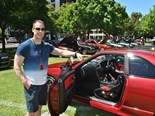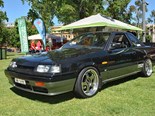Nissan Skyline GTS R31 - Buyer's Guide





































|

|

|

|

|

|

|

|

|

|

|

|

|

|

|

|

|

|
The Nissan Skyline might not top your list of must-have collector cars but it's a dependable classic with cross-cultural appeal. Here's what to look for
Nissan Skyline GTS
Although the brand was launched here by Sir Laurence Hartnett ('father of the Holden') in the early 1960s with the Datsun Bluebird, it was the Datsun 1600 of 1968 that made people notice Datsun in Australia. Assembled on Volkswagen Australia’s production lines in Clayton south-east of Melbourne, the Datto 1600’s willing 1.6-litre overhead cam motor, floor-shift four-speed and all-independent suspension made it a legend.
To cut a long story short, after the 1600, Datsun 180B, 200B and Bluebird – plus smaller models such as 1200, 120Y and Stanza, and a badge change from Datsun to Nissan – by the early 1980s, Nissan Australia decided to manufacture the Skyline locally to muscle-in on the six-cylinder market dominated by Falcon and Commodore.
| Gallery: Nissan Skyline Nationals 2016

The Skyline was not new to Australia – as the 240K (the Skyline’s name in several export markets) it arrived in Oz in 1973. Later, after being reassigned its real name, it was sold here as a premium sports/executive sedan and hatch. But Nissan Australia’s local engineers were confident they could adapt and modify the seventh-generation Japanese Skyline design, known as R31 and due in 1985, for Australian conditions.
Although the R31 Skyline was also developed in Japan with a two-door coupe and four-door hardtop (both with frameless windows) Nissan Australia chose only the conventional sedan and wagon for Australia. To keep costs down and durability up, the Japanese Skyline’s coil-sprung trailing arm independent rear suspension was binned in favour of an Australian-made Borg Warner live axle, as had occurred previously with the Australian-made 200B and Bluebird. Other JDM (Japanese Domestic Market) trinkets such as fluorescent instrument clusters and electrically adjustable dampers were ignored for Oz.
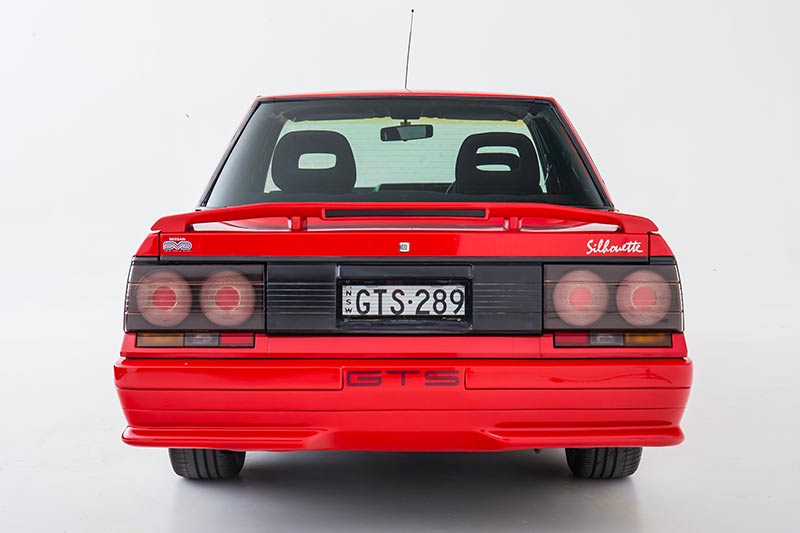
Nissan’s new range of in-line six-cylinder engines powered the R31 Skyline and other vehicles such as Patrol. Tagged RB, this versatile family of iron-block, alloy-head overhead cam engines was designed with capacities from 2.0 to 3.0-litres with various layouts of carburettor or EFI, single-cam/two valve and twin-cam/four-valve heads (some with butterfly intake runners) and naturally-aspirated or turbo induction. Nissan Australia negotiated to buy a big-capacity fuel-injected 3.0-litre single-cam RB30E version to provide the torquey low-down response that Aussie drivers wanted and to comply with Australia’s new-for-’86 unleaded petrol emissions regulations. Helping this situation, no doubt, was the fact that Holden had negotiated to buy the imported RB30E six-cylinder engine for the 1986 VL Commodore so the business case stacked up.
THE MODEL RANGE
The R31 Nissan Skyline arrived in July 1986. Style-wise, like many cars of the 80s, the new Nissan looked as if it’d been drawn by a kid with a pencil and ruler. From a distance, the Skyline’s extra driving lights mounted inboard of the headlamps differentiated it from the four-cylinder Pintara.

The 3.0-litre engine was standard in all: GX and GXE sedans and wagons and the sedan-only Ti and Silhouette. It offered 117kW and 252Nm and either a five-speed manual or four-speed auto transmission and all Skylines were well-equipped for the time with four-wheel discs and power steering. Wheels were 14s on lower-spec cars and 15s on the luxury Ti and sports-pack Silhouette.
It’s nowhere near as interesting, but the Skyline had a 2.0-litre four-cylinder Pintara sister, too. Having a four-cylinder model using the same sedan and wagon bodies allowed Nissan Australia to chase the four-cylinder Holden Camira, Mitsubishi Sigma and Toyota Camry as well as six-cylinder Commodore/Falcon family and fleet markets.
Of course, being based on a Japanese design (where smaller cars attract less tax), the Nissan was narrower inside than the Holden Commodore and – especially – Ford’s Falcon which made the rear seat a little squishy for the third kid or the probationary constable. The Skyline used gearing around five per cent lower than Commodore so it was a rewarding drive. When WHEELS magazine compared Skyline to the VL Commodore in mid-1986, it was regarded as the better-built, more hushed, better-handling and better-performing car.
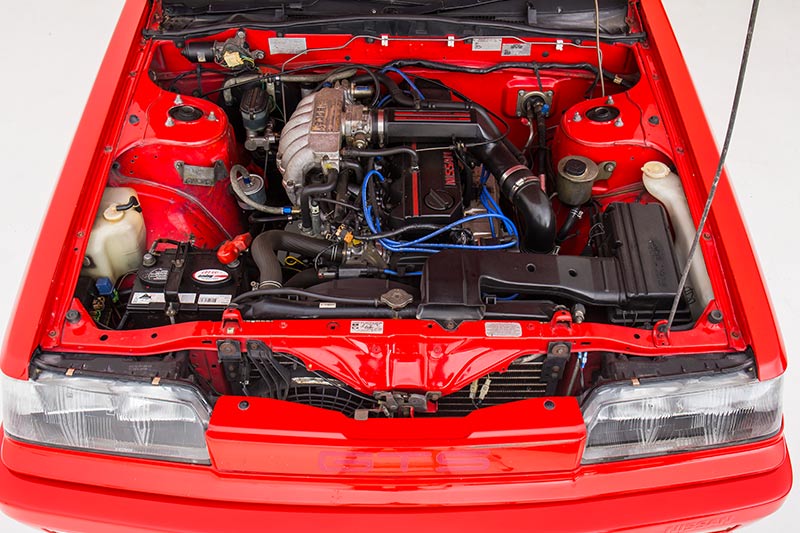
To Nissan Australia’s credit, performance was something it promoted in its magazine and TV advertising, using such hook-lines as: "The Pure Performance of Car and Engine." Nissan Australia had a strong presence on Aussie racetracks, too, and linked the Skyline’s advertising with the factory-backed racing activities of Mark Skaife and Jim Richards in a Gibson Motor Sport-prepped Skyline GTS-R against the Holdens and Fords of other racing legends such as Peter Brock and Dick Johnson.
It also established a Special Vehicles Division. One of the results for enthusiast drivers was the Nissan SVD Skyline Silhouette GTS. Launched in mid-1988, the GTS was available as auto or manual but in white only and received several mechanical and handling upgrades to create a ‘club sport’ type vehicle. The imported engine was tweaked with a locally installed camshaft and extractors to lift power to 130kW at 5500rpm and torque from 247 to 255 Nm. Peak power and torque arrived 300rpm higher in the rev range, giving the engine an extra keenness for revs and SVD fitted oil and auto trans coolers.
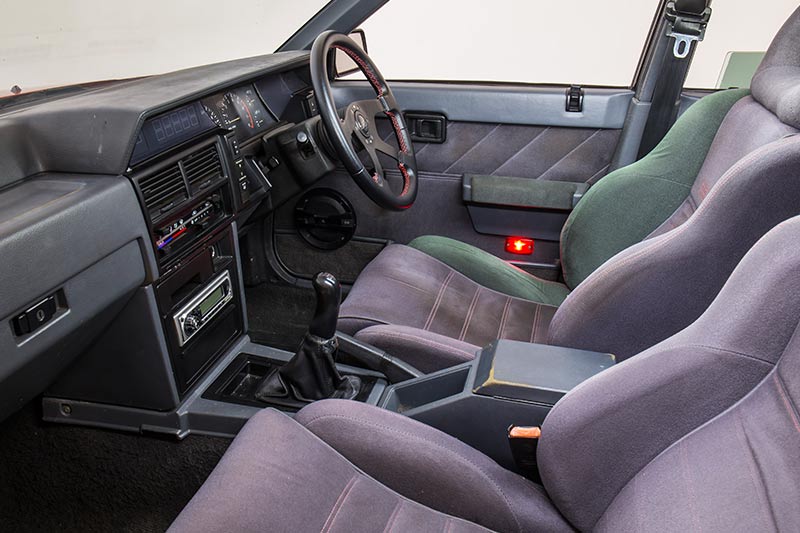
The GTS also had thicker sway bars, Bilstein dampers and larger 274mm front brakes, raided from the Japanese-market Skyline parts shelf. It all worked with 16x7-inch alloys and 215/55 tyres with the driver sitting on locally-made Scheel seats and holding a Momo wheel.
In mid-1988, the Skyline range received a styling update. Dubbed Series 3 (the Series 2 didn’t amount to much!) the front-end styling was sharpened with less-bluff headlights and Nissan’s trade-mark stove-top style tail lights were fitted. There was a minor jiggling of specifications and a new Executive model appeared. Then (and now) a style signature of Japanese-market Skylines, the Aussie model’s lights were somewhat hidden behind grey-frosted covers.
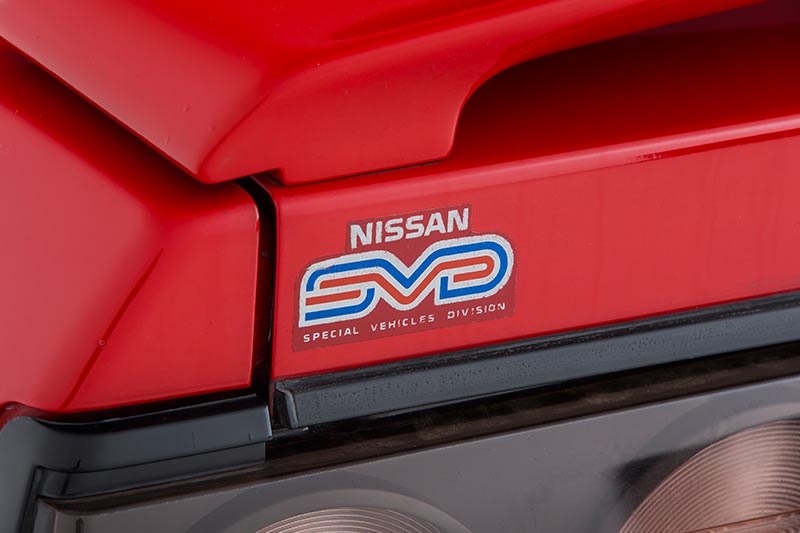
Nissan SVD launched a second GTS in mid-’89. This time the car was presented in a far more extroverted Beacon Red with white 16-inch wheels. Representing the Skyline model range here in our studio photo shoot, the GTS2 had more power thanks to more extensive changes to the engine: an extra 10kW (to 140kW at 5600rpm) thanks to stainless extractors and a modified cam (as before) but with head porting and a piggy-back computer to change the engine’s fuelling. There was a lower-than-standard diff ratio too, for even better on-road urge.
The second GTS’s interior was restyled; the rear seat was heavily sculpted to match the front Scheels. There was a Momo steering wheel and the trim was a charcoal grey. As with the white GTS, the build run was 200 and all cars had a numbered dashboard badge.
Skyline production ended in 1990 and Nissan Australia stopped building cars here soon after.

FINDING ONE TODAY
A good Nissan Skyline remains a decent drive and with values for all models (except the two collectible GTSs) around $5K for a glorious, garaged, dad-spec stunner, a Skyline is a useful and fun car for not much cash. But being the age it is means that safety technology is almost non-existent – no ESP, ABS nor airbags – so it might be a classic for consideration by more experienced drivers.
The RB30 engine was – and remains – a highlight and older enthusiasts will remember this engine being controversial on its introduction for its use in the 1986 VL Holden Commodore, too. However, despite being tagged ‘high tech’ – and therefore fragile by the flat-earth theorists of the 1980s – it’s a very durable and long-lived design with many showing in excess of 400,000km with little more than routine servicing. In fact, modified turbocharged versions of the RB30 – especially in VL Commodores, where a turbo version of the engine was an option – with almost stupid horsepower levels are a street machine sub-culture, backing-up the strength and reliability of the design.
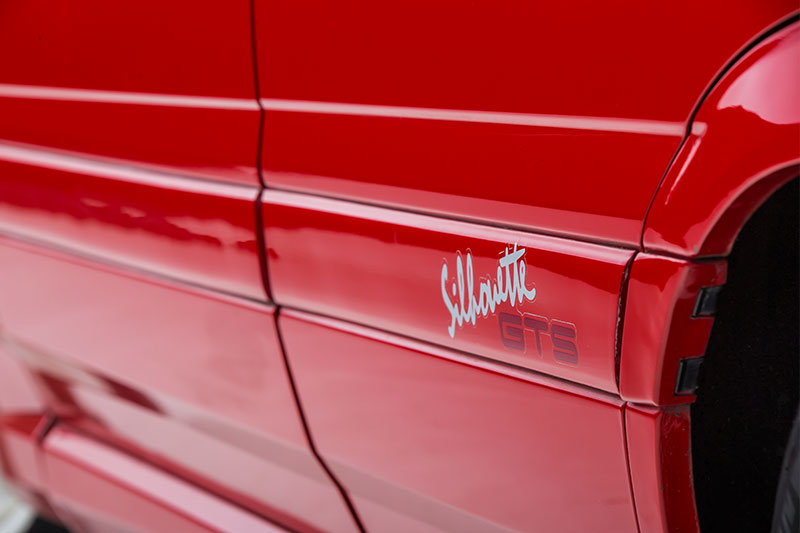
The engine’s camshaft is driven by a toothed rubber belt which needs replacement every 100,000km but thankfully the RB engine’s pistons do not smash into valves if the belt breaks. As a precaution, replace the water pump at the same time as the cam belt; the belt must be removed to access the pump. As with any iron block/alloy head engine, using the proper coolant is very important to prevent corrosion. The EFI system (Nissan's ECCS – Electronic Concentrated Computer System) is very simple with the diagnostics provided by two flashing LEDs on the side of the PCM which is installed in the cabin.
RB30 injectors, air flow meters and other components are quite durable and not yet a parts supply headache. A common problem is the auxiliary air valve not working; this AAV is a mechanical air bypass that allows the engine to idle faster (around 1200rpm) when cold, gradually closing-off the extra air as the engine warms up. Cleaning may rectify it.
The five-speed manual and four-speed auto gearboxes were imported with the engines. The auto features a torque convertor lock and has a tendency for a firm shift – thoonk – between first and second gear. Many autos have had plenty of skipped services in the past 15-20 years as these cars became $1500 clunkers so put the auto on your list of service items if you find a good one. Its use – and continuing popularity – in the VL Commodore means knowledge isn’t difficult to find.
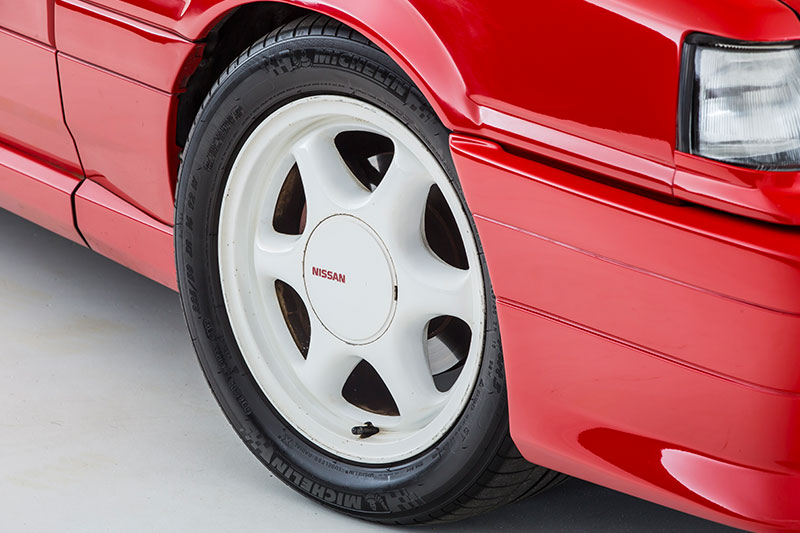
The front suspension is struts with rack and pinion steering with the live rear axle also on coils. As mentioned, the brake system is all-disc with Aussie Girlock-made sliding-head calipers over vented front for the mainstream models. Pads and parts are generally easy to source but the GTS’s larger front rotors are becoming very difficult to find. There are minor differences in rear caliper designs; one type is impossible to get rebuild kits for: cross that bridge if/when you need to.
When near-new, some Skylines suffered a howling diff; with Borg Warner, Nissan honoring replacement of the rear axle far beyond its standard two year/40,000km warranty. Apart from that, the diff is no more or less troublesome than a Falcon or Commodore item. However, the Skyline’s snappy diff ratio is a great performance upgrade for a fast Falcon or Commodore and the Skyline’s light alloy rear disc brake calipers, with integral handbrake mechanisms, are popular for disc conversions on other vehicles so the rear axle with brakes is usually the first thing sold from a Skyline being parted-out.
Skylines have one rust horror story: the plenum drain and the welded joins mid-way up the A pillars – hidden by the front guards. Removing the side repeater light gives a window for inspection. The stainless-steel garnishes around the front and rear screens also hold dirt and moisture and therefore rust, as does the boot seal and tail light surrounds – a common problem with many makes of cars.
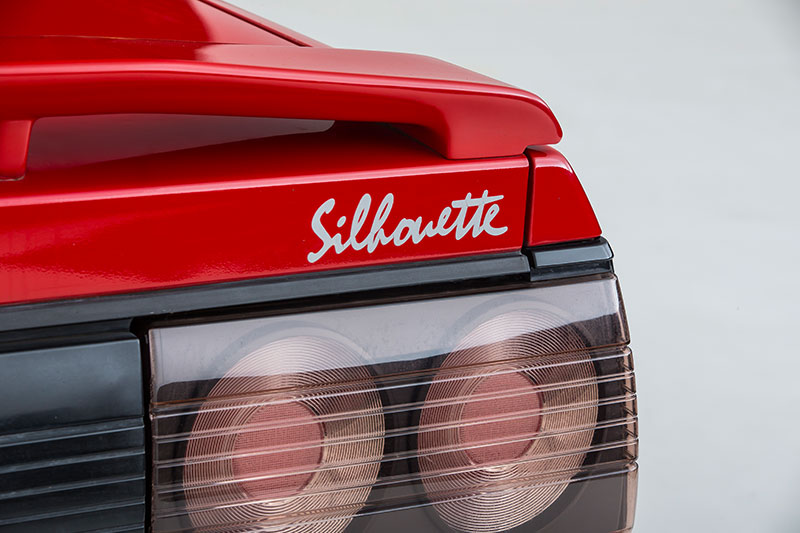
The seating is excellent and seat fabrics durable but the Skyline’s interior plastic components don’t cope too well with age, becoming crusty. Door lock buttons and window winders are a loose fit in their apertures and there are lots of separate components in the dash, all of which conspire to create annoying sizzles and rattles. Thankfully the headliner is an old-school design strung on wire rods so it doesn’t droop like many hard-backed headliners do. Other components, such as the locally-developed air-con, don’t have a reputation for rotten reliability but as with any older car purchase, it’s far more sensible to find a well-maintained car where everything works than patch up a clunker, especially as there aren’t many Skylines remaining.
DRIVING ONE TODAY
Thanks to their durability the last of the Aussie Skylines are still being bombed around by P-platers while the first of them (1986) are now eligible for Historic Club rego in all Australian states meaning a good one is a great candidate for a not-another-Holden-or-Falcon-or Mustang Coffee ‘n Cars cruiser.
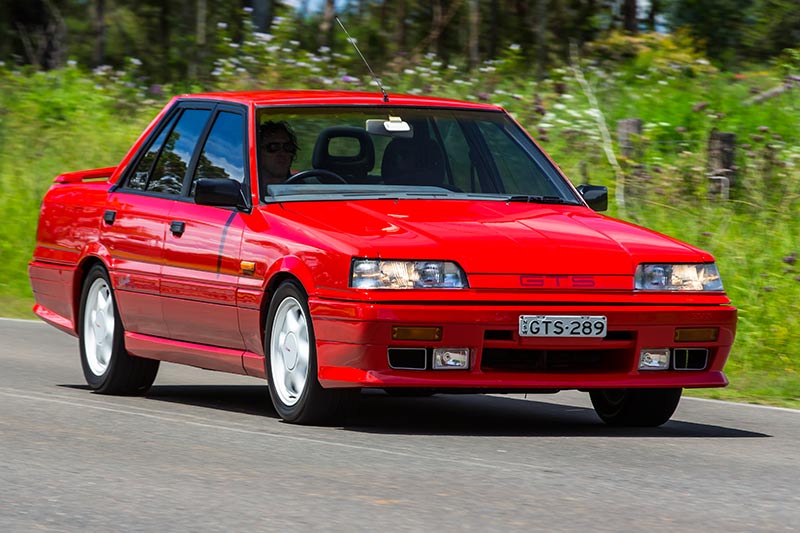
Sure, Skylines may not have quite the same Brock-esque aura of an early Commodore but broad-minded Aussie car enthusiasts recognise the heritage shared with some of the Japanese-market hi-per and turbo Skylines and will remember the 1980s racing Skylines just prior to the ‘Godzilla’ GTR. More recently, our Aussie Skylines – and the Japanese models on which they are based – have gained a bit of cred with the track sport of drifting. Helping this is the variety of Japanese-market turbo RB motors available in Australia (and EnZed) through specialist importers. They’re not much more than an easy bolt-in fit into the Skyline and with turbo tweaks, offer tyre-hazing performance.
No matter what, the Skyline is a recognisable slice of the 80s Aussie motoring scene and plenty of us Gen-Xers hung our P-plates from one. A stocko Skyline – especially a snazzy Silhouette or a Ti – remains a comfortable, economical and fuss-free daily driver, capable of light towing and interstate cruising. Jump on a nice one before
the last remaining good 'uns are turned into drift pigs.
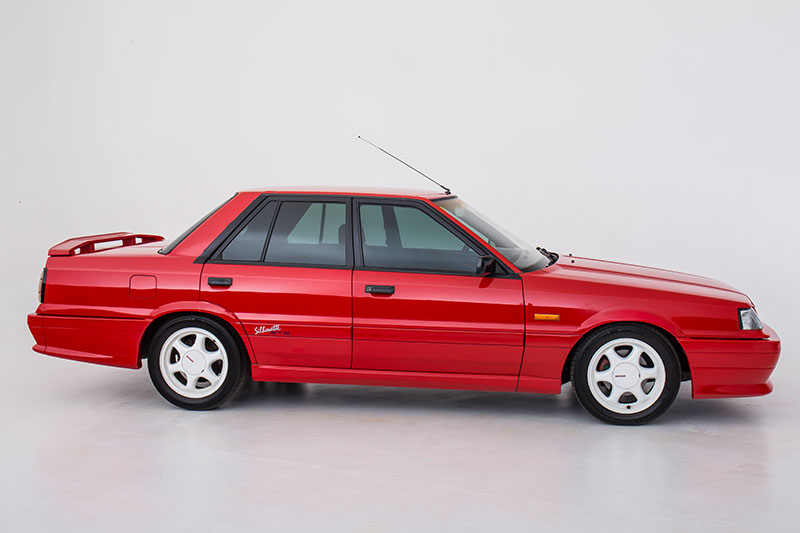
BUYER'S CHECKLIST
Body & Chassis
With smaller spans between major components, the Skyline is quite tough and stiff. The ruggedness of its monocoque construction can ultimately be compromised through complex, multi-piece stainless and rubber trim pieces around all window locks allowing in dust and muck, thus promoting rust. Tail light apertures, too, can rust badly although necessary repairs are not line-of-sight. Evil structural rust occurs half-way down A-pillars – hidden from sight – but inspection of the ends of the firewall/plenum box (from under the bonnet) might give a few clues. Paint will more than likely be dull and lifeless by now – especially metallic – but many cars’ appearance will be lifted by wet-sand and buff or bonnet/roof/boot respray.
Engine & Suspension
Cam belts require changing every 100,000km. Coolant type is important to prevent the alloy head and iron block (and intake manifold) cannibalising each other into a cruddy mess. Oil change intervals of 5000km are more sensible than the specified 10k to keep the hydraulic lifters clean. EFI is reliable, but distributor sensor circuits can give problems, as can the air-flow meter. Make sure all intake plumbing is in place.
Check the five-speed’s synchros with brisk shifts when warm. Autos can suffer from harsh shifts at part-throttle; budget $300 for a service –with falling values and less use for most of these cars, chances are it hasn’t been done in a decade. Diff design is shared with Commodore/Falcon: also tough and long-lived. You’ll hear a bad one before it stops.
Suspension & Brakes
Standard four-wheel disc brakes use similar (but not the same) Aussie-made components to other Aussie cars (Sigma, Commodore) and pre-date ABS and other tech so rebuild kits and parts aren’t yet a problem. However one type of rear caliper will need replacement rather than reconditioning. Top-line GTS models’ front brake spec differs and is difficult to find these days but enthusiasts club and FB pages can yield parts. Front and rear strut-type suspension on the beam rear axle is similarly foolproof but with rear strut/spring/damper units’ direct connection to the body shell near rear seat occupants, rear suspension noise is often evident. As it is for most classic cars, too-low suspension is another ‘back away and run’ type situation.
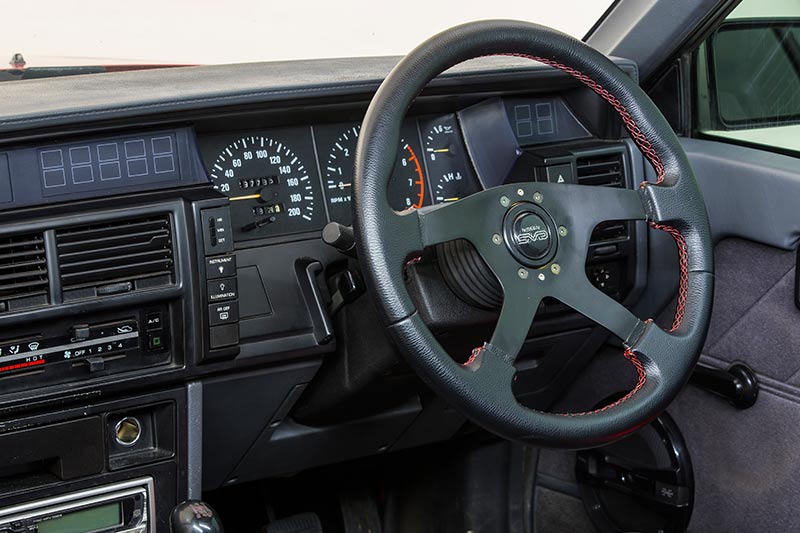
Interior & Electrics
Interior plastic quality lets the Skyline down: multi-piece dash and instrument binnacle leads to movement between parts and hence squeaks and rattles but is more durable than many cars under Aussie sunshine. Several other plastic interior components tend to go crusty and biscuity. Door lock snipper buttons rattle. Aussie-made instruments are generally reliable but labelled plastic covers over centre-stack switch gear can dislocate. Cloth seats in all models right up to the luxury rouged velour in Ti is quite durable but any car this age will be looking a little tired and emotional. Unlike local Ford and Holden products, seat fabrics are just about impossible to source and restore so kays and condition counts.
VALUE RANGE: Nissan R31 Skyline
FAIR: $5000
GOOD: $10,000
EXCELLENT: $25,000
1986-1991 Nissan Skyline Specs
Body style: all-steel monocoque four-door sedan, four-door station wagon
Engines: 2962cc in-line six cylinder with overhead camshaft and EFI
Power & Torque: 117kW @ 5200rpm, 252Nm @ 3600rpm
Performance: 0-100km/h – 9.3 seconds (manual)
Transmission: five-speed manual, four-speed automatic
Suspension: Front: independent with coil-springstruts & anti-roll bar and telescopic shock absorbers. Rear: beam axle with struts and telescopic shock absorbers
Brakes: four-wheel discs, power assisted
Unique Cars magazine Value Guides
Sell your car for free right here
Get your monthly fix of news, reviews and stories on the greatest cars and minds in the automotive world.
Subscribe

.jpg)








